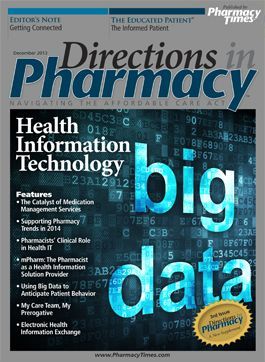Publication
Article
Pharmacy Practice in Focus: Oncology
Not Your Parents' Pharmacy Fill System: High-Tech, High-Touch
Author(s):
Big changes in pharmacy technology will affect the ways that pharmacists communicate with patients and health care providers.

Big changes in pharmacy technology will affect the ways that pharmacists communicate with patients and health care providers.
Meet Dave. He has hypertension. His doctor monitors his adherence with information transmitted by an ingestible sensor in his medication.
The sensor, about the size of a grain of sand, transmits a signal to a patch on Dave’s stomach. The patch contains another sensor that monitors his heart rate, body position, and activity level. It communicates data from both sensors to his smartphone via Bluetooth. The information also goes to a pharmaceutical company to help researchers better understand how Dave takes his medication and how his body responds to it.This product just secured approval by the FDA and is one of many innovations under development that would support health care providers in their efforts to improve health outcomes and lower medical costs. It also forecasts big changes for pharmacy technology in a coordinated care health system.
Here’s a look at key functions pharmacy fulfillment systems must incorporate to support high-tech, high-touch health care delivery.
Interconnectivity. For decades, community pharmacists have been accessible members of a patient’s health care team. Now, technology must elevate the pharmacist’s role to the level of other health care providers by connecting them to health information exchanges (HIEs) for fast, secure communication of vital medical information, such as continuity-of-care documents. Key information tracked at the pharmacy, including refill records, medication possession ratio, and patient interaction notes, should be pushed to other providers involved in a patient’s care via HIEs.
Patient engagement. Pharmacists have a key ingredient that motivates patients to make good choices: trust. They are second only to nurses in Gallup’s annual poll that ranks the most trusted professionals in the country. And unlike doctors’ offices, where patients work around physician availability, pharmacists work on patient timelines. Technology must leverage that accessibility and become an extension of the pharmacist’s clinical thinking, enabling medication synchronization and multi-dose packaging of medications the way people take them: by date and time of day, prompting intervention for at-risk patients and plugging into other provider-patient scheduling capabilities. Additionally, innovations in telemedicine can create a lifeline between pharmacists and patients to provide remote counseling and critical medication therapy management. It also brings the added benefit of balancing workloads across multiple pharmacy locations to maximize labor efficiency.
Integration with automation. For decades, pharmacy technology has automated the “count, pour, lick, and stick” process and eased verification to free time for pharmacists to counsel patients. Now, it must ensure that pharmacists have the time and the tools to communicate with other health care providers and provide high-touch, high-value patient services that promote positive health outcomes. The integration of robust pharmacy robotic systems with information technology platforms is enabling pharmacists to strengthen their patient value proposition while anticipating emerging technology, such as Dave’s ingestible sensor.
To get there, pharmacy technology innovators might think of the pharmacist as the conductor in the symphony of a patient’s medication management regimen. Technology systems must empower pharmacists in that role—connecting them to each of the health care providers who work with them—and easing the exchange of vital, relevant medication information with patients to support outcomes-based care.
Tom Rhoads is chief executive officer of Parata Systems, a leading provider of technology solutions to support coordinated care, better health outcomes, and lower medical costs, empowering pharmacists to grow their businesses. He recently convened Parata’s inaugural Innovation Summit, a 2-day industry leadership idea exchange on pharmacy, technology, and evolving health care partnerships.Rhoads’ previous experience in the health care industry includes Baxter Healthcare and Cardinal Health Corporation. He is a graduate of Duke University, with an MBA from The Citadel. He serves on the Pharmacy Times Advisory Board, is a member of the North Carolina Technology Association, and the Chief Marketing Officer Council, and is an Iron Duke alumnus of Duke University. He also represents Parata with numerous pharmacy industry organizations, including the National Association of Chain Drug Stores and the National Community Pharmacists Association. Parata and Pharmacy Times are partners in the Next-Generation PharmacistTM Awards, the national program recognizing pharmacy innovation and leadership, which is entering its fifth year in 2014.







